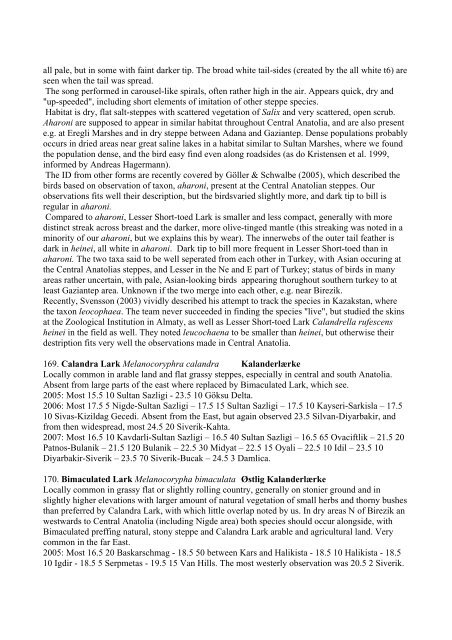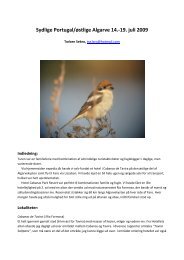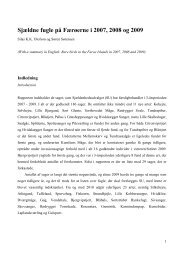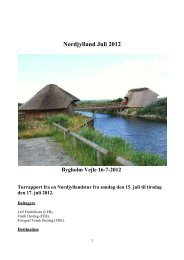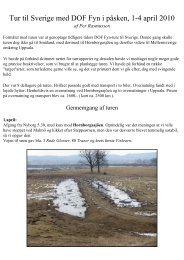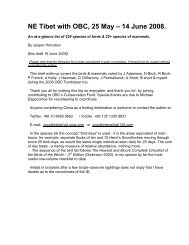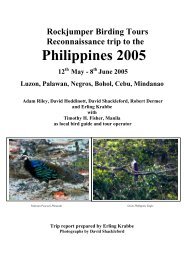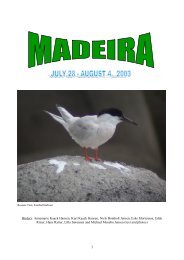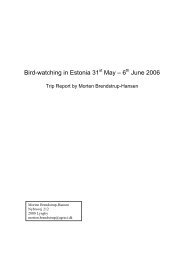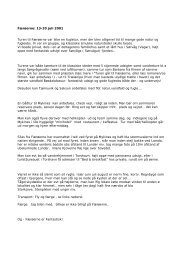TURKEY - a report from a birdwatching trip to Central ... - Netfugl.dk
TURKEY - a report from a birdwatching trip to Central ... - Netfugl.dk
TURKEY - a report from a birdwatching trip to Central ... - Netfugl.dk
You also want an ePaper? Increase the reach of your titles
YUMPU automatically turns print PDFs into web optimized ePapers that Google loves.
all pale, but in some with faint darker tip. The broad white tail-sides (created by the all white t6) are<br />
seen when the tail was spread.<br />
The song performed in carousel-like spirals, often rather high in the air. Appears quick, dry and<br />
"up-speeded", including short elements of imitation of other steppe species.<br />
Habitat is dry, flat salt-steppes with scattered vegetation of Salix and very scattered, open scrub.<br />
Aharoni are supposed <strong>to</strong> appear in similar habitat throughout <strong>Central</strong> Ana<strong>to</strong>lia, and are also present<br />
e.g. at Eregli Marshes and in dry steppe between Adana and Gaziantep. Dense populations probably<br />
occurs in dried areas near great saline lakes in a habitat similar <strong>to</strong> Sultan Marshes, where we found<br />
the population dense, and the bird easy find even along roadsides (as do Kristensen et al. 1999,<br />
informed by Andreas Hagermann).<br />
The ID <strong>from</strong> other forms are recently covered by Göller & Schwalbe (2005), which described the<br />
birds based on observation of taxon, aharoni, present at the <strong>Central</strong> Ana<strong>to</strong>lian steppes. Our<br />
observations fits well their description, but the birdsvaried slightly more, and dark tip <strong>to</strong> bill is<br />
regular in aharoni.<br />
Compared <strong>to</strong> aharoni, Lesser Short-<strong>to</strong>ed Lark is smaller and less compact, generally with more<br />
distinct streak across breast and the darker, more olive-tinged mantle (this streaking was noted in a<br />
minority of our aharoni, but we explains this by wear). The innerwebs of the outer tail feather is<br />
dark in heinei, all white in aharoni. Dark tip <strong>to</strong> bill more frequent in Lesser Short-<strong>to</strong>ed than in<br />
aharoni. The two taxa said <strong>to</strong> be well seperated <strong>from</strong> each other in Turkey, with Asian occuring at<br />
the <strong>Central</strong> Ana<strong>to</strong>lias steppes, and Lesser in the Ne and E part of Turkey; status of birds in many<br />
areas rather uncertain, with pale, Asian-looking birds appearing thorughout southern turkey <strong>to</strong> at<br />
least Gaziantep area. Unknown if the two merge in<strong>to</strong> each other, e.g. near Birezik.<br />
Recently, Svensson (2003) vividly described his attempt <strong>to</strong> track the species in Kazakstan, where<br />
the taxon leocophaea. The team never succeeded in finding the species "live", but studied the skins<br />
at the Zoological Institution in Almaty, as well as Lesser Short-<strong>to</strong>ed Lark Calandrella rufescens<br />
heinei in the field as well. They noted leucochaena <strong>to</strong> be smaller than heinei, but otherwise their<br />
des<strong>trip</strong>tion fits very well the observations made in <strong>Central</strong> Ana<strong>to</strong>lia.<br />
169. Calandra Lark Melanocoryphra calandra Kalanderlærke<br />
Locally common in arable land and flat grassy steppes, especially in central and south Ana<strong>to</strong>lia.<br />
Absent <strong>from</strong> large parts of the east where replaced by Bimaculated Lark, which see.<br />
2005: Most 15.5 10 Sultan Sazligi - 23.5 10 Göksu Delta.<br />
2006: Most 17.5 5 Nigde-Sultan Sazligi – 17.5 15 Sultan Sazligi – 17.5 10 Kayseri-Sarkisla – 17.5<br />
10 Sivas-Kizildag Gecedi. Absent <strong>from</strong> the East, but again observed 23.5 Silvan-Diyarbakir, and<br />
<strong>from</strong> then widespread, most 24.5 20 Siverik-Kahta.<br />
2007: Most 16.5 10 Kavdarli-Sultan Sazligi – 16.5 40 Sultan Sazligi – 16.5 65 Ovaciftlik – 21.5 20<br />
Patnos-Bulanik – 21.5 120 Bulanik – 22.5 30 Midyat – 22.5 15 Oyali – 22.5 10 Idil – 23.5 10<br />
Diyarbakir-Siverik – 23.5 70 Siverik-Bucak – 24.5 3 Damlica.<br />
170. Bimaculated Lark Melanocorypha bimaculata Østlig Kalanderlærke<br />
Locally common in grassy flat or slightly rolling country, generally on s<strong>to</strong>nier ground and in<br />
slightly higher elevations with larger amount of natural vegetation of small herbs and thorny bushes<br />
than preferred by Calandra Lark, with which little overlap noted by us. In dry areas N of Birezik an<br />
westwards <strong>to</strong> <strong>Central</strong> Ana<strong>to</strong>lia (including Nigde area) both species should occur alongside, with<br />
Bimaculated preffing natural, s<strong>to</strong>ny steppe and Calandra Lark arable and agricultural land. Very<br />
common in the far East.<br />
2005: Most 16.5 20 Baskarschmag - 18.5 50 between Kars and Halikista - 18.5 10 Halikista - 18.5<br />
10 Igdir - 18.5 5 Serpmetas - 19.5 15 Van Hills. The most westerly observation was 20.5 2 Siverik.


